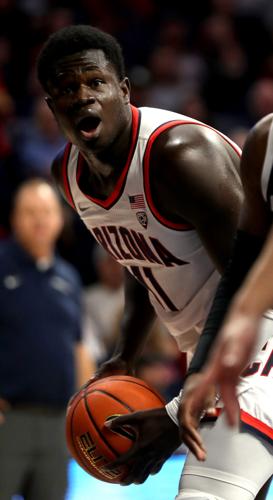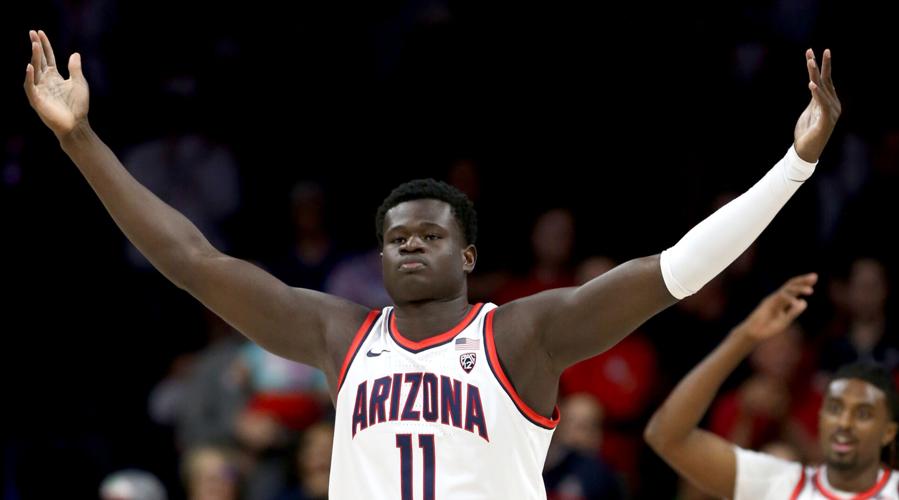Since leaving his west African home of Mali at 13, Oumar Ballo played and studied two years at a basketball academy in the Canary Islands, two years at the NBA Latin American Academy in Mexico City, followed by two bench-riding years at Gonzaga,
One and done? This is not a Deandre Ayton story.
“Honestly, at Gonzaga there were so many times I thought I’d go back home,” Ballo said Tuesday at McKale Center. “The pace was so fast and physical. I had never been part of anything like it. I just didn’t know if I could pull it off.
“But I had been through the same struggle before — living in a new country — and I decided that if I did it at 13, I could do it again.”
Overnight success? Hardly.
Ballo didn’t prosper at Gonzaga. He redshirted as a 17 year-old-freshman, underwent ankle surgery, and struggled to get playing time a year later, scoring fewer points in his redshirt freshman season (60) than he did last week at the Maui Invitational (63).
Arizona coach Tommy Lloyd, who had recruited Ballo to Gonzaga, is not a rush-job coach. He’s a developer, a coach who might lead the NCAA in patience. Asked about Ballo’s slow but sure path to becoming the Maui MVP last week, Lloyd all but shrugged.
“Just because it didn’t happen early doesn’t mean it’s not going to happen later,” he said.
One thing Lloyd has learned the last four years is that there’s no quit in Ballo, who, despite his intrepid journey from Mali to McKale Center, is only 20 years old. He won’t turn 20½ until January.
It has become an education in much more than basketball X’s and O’s.
When Ballo arrived in Tucson in the summer of 2021, he was greeted by a challenge as difficult as that he encountered at Gonzaga. The UA’s accomplished strength and conditioning coach, Chris Rounds, envisioned a more fit, sleek and powerful Ballo, not a deep-in-the-paint player that some might expect given Ballo’s 7-foot, 275-pound frame.
Or as Lloyd would say, not just a rim-protector, but a run-the-court rim-attacker.
But Ballo’s relationship with Rounds wasn’t an immediate fit.
“I was trying to push him away, not letting him do his job. I was too hard-headed,” Ballo remembers. “But he wouldn’t let up, he kept coming. He told me I wouldn’t be able to play Tommy’s system unless I changed my body. Finally, I figured out he was trying to make me a better, more explosive athlete. He wanted to get me where I wanted to be, so at some point I started liking what he was doing. I started seeing results. Today, my workout routine is pretty intense.”
Ballo is still 7-feet and about 275 pounds, but the weight is distributed differently. His lower body strength has improved significantly. His endurance shifted from that of a half-court player to perhaps the most effective baseline-to-baseline big man in college basketball.
“I’m so much stronger on my feet,” said Ballo. “I don’t get tired and I love running the court. Letting (Rounds) do his job was one of the best decisions I’ve ever made.”
Best decision? Last week in Hawaii Ballo scored 63 points in three days, grabbed 32 rebounds and shot 77% in a three-day endurance test against elite competition.
Who is this guy, Shaquille O’Neal?

With the help of strength coach Chris Rounds, Oumar Ballo has redistributed his weight and become a better floor-runner.
Ballo played 89 minutes in last week’s exhausting three-game-in-three-days tournament in Maui. He got better as others around him began to tire. In the championship game against No. 10 Creighton, Ballo made 14 of 17 shots and grabbed 13 rebounds. It rivals any performance by an Arizona big man over the last 50 years.
A year ago, backing up Christian Koloko, Ballo played just 37% of available minutes. This year he is playing 65%. His numbers are superior to those of Koloko, now a Toronto Raptors center; Ballo is averaging 19 points, Koloko averaged 12.6. Ballo averages 10 rebounds, Koloko averaged 7.3. Ballo is shooting 77%; Koloko shot 64%.
True, Arizona is a mere six games into the season, but Ballo’s enthusiasm for Lloyd’s run-and-shoot offense suggests that this is no fluke, much the way last season’s 33-4 finish was nowhere near what the experts predicted in the preseason.
“At Arizona, you have to run, and when you do, you get rewarded for it,” said Ballo. “(Kerr) Kriisa is going to find me and get me the ball. Pelle (Larsson) is going to find me. (Azuolas Tubelis) is one of the best-running big men ever. For me to see him do it, I want to do the same. It all fits.”
A year ago at this time, through six games, Ballo averaged just 13 minutes a game. By season’s end, he scored just four points in the NCAA Tournament. That’s when patience, trust and hard work kicked in.
Ballo is now viewed by some as the nation’s top big man, or in a group with the best.
“When Oumar was struggling at Gonzaga (and early at Arizona), I was still behind him,” said Lloyd. “It was just a chapter in a bigger story.”
McKale Center was built at the University of Arizona in the early 1970s. There have been updates through the years.






